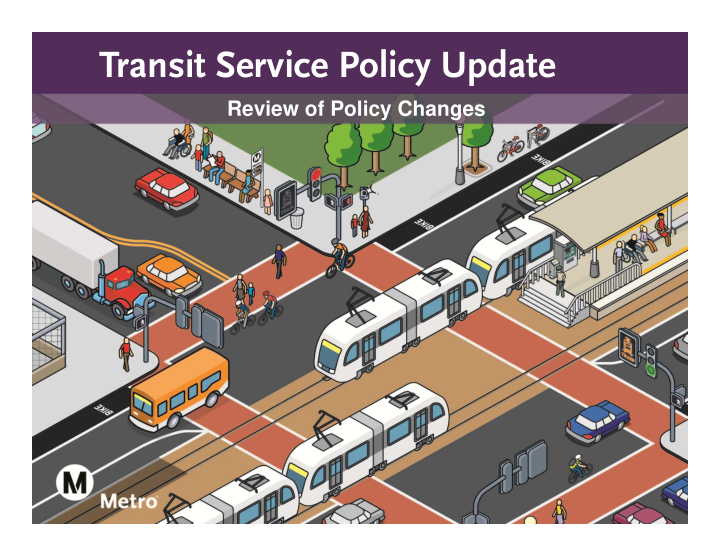



Transit Service Policy Update Review of Policy Changes
Transit Service Policy • What is the Transit Service Policy? Key policy document that establishes: • A formal process for evaluating existing services • A methodology and process for developing and • implementing service changes Service design guidelines to provide high • quality services to our customers and encourage ridership 2
Transit Service Policy • 2012 was the Last Update Adopt Revised Stop Spacing Standards • Change Load Factor to 1.3 x Seated Load • • 2015 Update Timely • Opening two Rail Lines in Spring 2016 • Assumption of no increase in the level of bus • service hours APTA Peer Review Recommendations (3/2015) • 3
Transit Service Policy • Basic Policy Changes Increase load factor on our most frequent lines • Consolidate bus stops to increase speed • • Consider network of frequent services with focus on supporting core Bus & Rail lines • Reallocate resources from poorer performers to higher productivity lines • Improve coordination with Municipal Operators 4
Transit Service Policy Load Factor • Current: One standard: Peak / Off ‐ Peak, weekends, and any service frequency • Proposed Standard – Variable Standard considering: • Peak / Off ‐ Peak • Bus Type • Service Frequency Variable loading standards can produce efficiencies 5
Loading Standards by Bus Size Weekday AM and PM Periods Off Peaks and Weekends Bus Types Bus Types 40 ft. 45 ft. 60 ft. 40 ft. 45 ft. 60 ft. Frequency Frequency Psgrs. / Psgrs. / Range in Range in Seat Seat Average Peak Loads Average Peak Loads Minutes Minutes 1 ‐ 10 1.40 56 65 80 1 ‐ 10 1.30 52 60 74 11 ‐ 20 1.30 52 60 74 11 ‐ 20 1.25 50 58 71 21 ‐ 40 1.20 48 55 68 21 ‐ 40 1.10 44 51 63 41 ‐ 60 1.10 44 51 63 41 ‐ 60 1.00 40 46 57 60+ 1.00 40 46 57 60+ 0.75 30 35 43 Shaded area presents current load factor standard applicable at all times. This table replaces the all ‐ day 130% standard with one that varies by peak/off ‐ peak and schedule frequency. Wait a longer time; get to sit down 6
Transit Service Policy Stop Consolidation Focus • Metro has in excess of • Reduce stops that are less 15,000 bus stops than ¼ mile from each other • Over past 5 years, bus • Reduce stops that have little speeds on average have use declined (from 12 mph to • Decrease running time and less than 10.91 mph) improve service efficiency • As the system slows down, • Provide for smoother more resources needed to operation operate same headway • Improve safety • Greater opportunity for accidents 7
Transit Service Policy • Operate 15 ‐ Minute Peak Service Network Focus on Rail, BRT, Rapid, and other top • performing lines Follows grid pattern • One ‐ half to 1 ‐ mile spacing of lines • Better quality & more reliable service on high ‐ • performing lines Provides opportunities for other operators • 8
Recommended 15-Minute Peak Network 9
Metro-Municipal Operator Transit corridors considered for future operation by another operator should: Add value to the customer through integration into an already • established nearby transit operator; Complete another operator’s route network; • Improve connections to a municipal operator’s established network; • Generate net cost savings; Metro will calculate the FAP impacts for all • service realignment proposals If Metro service is reduced, Metro should reinvest at least half of the • net savings (operating cost less passenger revenue and FAP reduction) to improve service on Metro’s core network of regionally significant bus lines. 10
Service Change Timeline Required Lead Time Key Activities (Months Prior to Implementation) Initiate Planning Process 12 Develop Preliminary Recommendations 7 ‐ 8 Impact Analysis for Proposed Changes 6 ‐ 7 Title VI Equity Analysis on Major Service Change and 5 ‐ 7 Fare Change Proposals Service Council Review and Input 6 ‐ 7 Confer with Labor Relation and Union Representatives 5 ‐ 6 Public Review and Input 5 Finalize Service Change Program 4 ‐ 5 Program Approval 3 ‐ 4 Develop New Service Schedules 2 ‐ 4 Print Public Time Tables and Operator Assignments 1 ‐ 2 Fabricate Decals for Bus Blades 1 ‐ 2 Print Bus Cubes/Take ‐ One Bus Inserts 1 11
Next Steps • Initiate the Comprehensive Operations Analysis reviewing each line in the system • Make recommendations for service changes: – Achieve the Peak 15 minute Frequent Service Network – Place more resources on core network services, e.g. Rapid Bus Lines – Right ‐ size the owl service network – Provide opportunities for experimentation with point ‐ to ‐ point services 12
Project Timeline • Complete service evaluations by November 2015, establish phasing plan & analyses • Generate service changes for June 2016 by December 2015 (Service Councils set hearing dates) • Hold Public Hearings in February 2016 • Adopt service change program March/April 2016 • Implement Plan Phase July 2016 • Evaluate changes by October 2016 13
Transit Service Policy Update Questions ? Questions 14
Recommend
More recommend